Last updated on August 9th, 2025 at 01:04 pm
Xeriscape landscaping ideas for the desert southwest. I love Gardening and it is a great way to relax, and then enjoy the fruits of your labor, at least it is for me. But some have a hard time gardening or consider this hard work and don’t want to bother going outdoors and enjoy their landscape area.
Is Xeriscape gardening hard work?
Whether you have too much going on at work or too many kids to take care of, you should never garden if you don’t think you can handle it. So, what can someone do to fix this problem? Easy…you find plants and trees that do not require a whole lot of attention, water, and care. This article “Xeriscape landscaping ideas” will hopefully help you decide what type of plants to use.
Many large plants and or trees become drought tolerant simply by their growth. Once the root system gets large enough it will find water on its own. Via the water table below the ground.
Is it Xeriscape or Zero-Scape?
Do not confuse Xeriscaping with Zero-scaping. This landscape concept just rocks nothing else. It focuses on a yard with gravel or lava rock. This requires no maintenance whatsoever. But you will have a hard time explaining this type of landscape to City/County code officials. It’s important to note that if you live within the city limits civil codes do require so many plants per sq ft. for commercial or residential buildings.
What is Xeriscaping?
Xeriscaping is landscaping and gardening that reduces or eliminates the need for supplemental water from irrigation. It is promoted in regions that do not have easily accessible, plentiful, or reliable supplies of fresh water, and is gaining acceptance in other areas as access to water becomes more limited. Xeriscaping may be an alternative to various types of traditional gardening. Read more.
This post is for those who want easy-care, low water, and low-maintenance yards. I would highly recommend Xeriscaping for your landscaping needs.
A lot of folks think Xeriscaping is cactus, sandy soil, and dry-looking plants. This is partly true, however, with the right plants, it can be a colorful landscape design. It is a great method of having a great-looking yard or garden, without having to maintain it or water it very often at all.
Xeriscape landscaping ideas
Succulents are good flesh-like leaves and stem to use in a xeriscape design. Plants with, light-colored foliage are good plants to use since their surface will reflect the harsh sunlight. Small leaf plants have less area that is exposed to drying and extreme sunlight.
Here in the southwest where drought conditions are prevalent, many local nurseries offer xeriscaping plants. In addition to nurseries, most landscape designers or maintenance companies will help you design a xeriscape garden or yard.
There are also some good Xeriscape classes online to help you find and get the right kind of help. For instance, NMSU has a plethora of online help. Here is their link. Xeriscape Plants.
Drought Tolerant Plant Photos
Here are some plants and photos to help you decide what would work in your area.
Red Tip Yucca – (Hesperaloe parviflora) has Nice colorful red tip blooms during spring. They do fade away during mid-summer months. Used them in and around the rock landscape. Moderate watering during the first 2 years after initial planting.

Chamisa or rabbitbrush (Ericameria nauseosa) Easy-care yellow Rabbitbrush or Chamisa. The blooms will come out in about September and will bloom until late fall. Prune this plant back in early spring for some great fall color.

Ocotillo (Fouquieria splendens) – Is a low water plant. That will survive in the southwest desert with a small amount of rainfall during the monsoon seasons. The leaves are small, about the size of a nickel. They produce beautiful bright orange blooms in mid-spring. Perfect for that corner spot to keep animals and people off your property. For faster growth water more often. Do not add to the water drip system as too much water may cause it to develop root rot. More on the Ocotillo Plant.
The Ocotillo Plant

The Mesquite Tree
Is the Mesquite a tree (Prosopis glandulosa) or is it a large bush? In its natural habitat, it is a desert bush that needs little water and tolerates poor soils. Read more about this tree here—the Mesquite tree.

Texas Sages (Leucophyllum) The Heavenly Cloud sage below. The one on top is trimmed as a hedge. The one on the bottom is left alone to grow as a large shrub. Blooms usually occur during the rainy season in and around the Southwest. More on the Texas Sage Bushes.
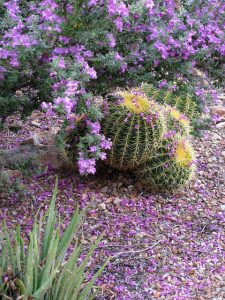
Colorful Cactus for Xeriscape Landscape Design
There are thousands of species and subspecies of cacti. Below is the common yellow flowering cactus, Cholla, and Barrel cactus. The blooms are a spectacular purple color. They will bloom mainly in the mid-spring through the early summer seasons. You only need to water it at the time of planting. Do not use a drip or sprinkler system on the cactus. They will survive with the little rainwater we get here in the southwest.




Agave (Agave americana) There are hundreds of varieties. The most common one is pictured below. It is also, known as “The Century Plant” because it takes forever for the plume to shoot out, and when it does it will look spectacular then tip over and fall. That is ok because the plant will look good for well…a century.


Rocky Mountain Penstemon (Penstemon strictus); Perfect for full sun blooms throughout the spring season. Plant them in mass and in the background in front of shorter plants. Not as showy during the mid-summer months. Xeriscape landscaping ideas for your home.
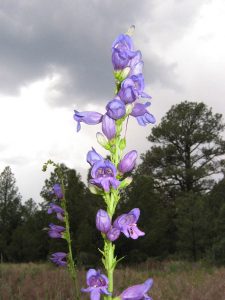
Spanish Broom – (Spartium junceum) Also called Weaver’s broom. This plant thrives in dry hot conditions and tolerates poor soil. It will get about 6-8 ft tall and about 4 ft wide. Nice bright yellow very fragrant blooms in midsummer. More about the Spanish broom plant.
Apache Plume (Fallugia paradoxa) Drought a tolerant southwestern plant. A native southwestern plant with small white flowers resembling a single rose bloom. After the bloom expires it turns into a fluffy white seed head. A hardy tuff plant that will grow to about 6 ft. wide and 8 ft. tall.
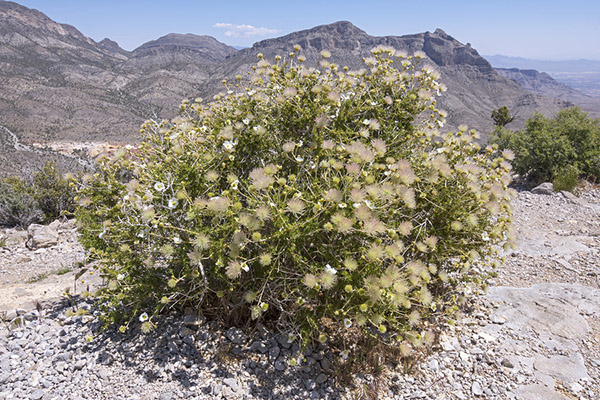
Yuccas for Desert landscape
Variegated Spanish Dagger (Yucca gloriosa ‘Variegata’) A great-looking Yucca with rigid variegated fronds can be planted in full sun or in a container as shown below.

Yucca’s (Yucca elata) – Also known as the SoapTree Yucca. It can be used for xeriscape landscapes. Use them in rock gardens or desert landscape designs. Drought tolerant and very little water. Beautiful spiky blooms in mid-summer. They will fall so some maintenance is involved after spikes fall on the ground.

Blue Yucca – Another great-looking Yucca plant in the ground or in a container. Lower water and very little maintenance.
Xeriscape landscaping ideas
Oleanders (Nerium) – Many people do not like these plants, but I love them. Oleanders are drought tolerant after they get established. Typically, around the 3rd year after planting. Great flowering color all mid-spring till about mid-summer. The white, pink, and red oleanders are the most common. They will grow to about 15-20 ft. Tall and wide.
You can also trim them into a small colorful tree. They require little to no water once it has been established. Makes a great screen or border plant. Perfect for a Xeriscape yard. Yes, these plants have a high degree of toxicity. Learn about Oleander Plant Care.
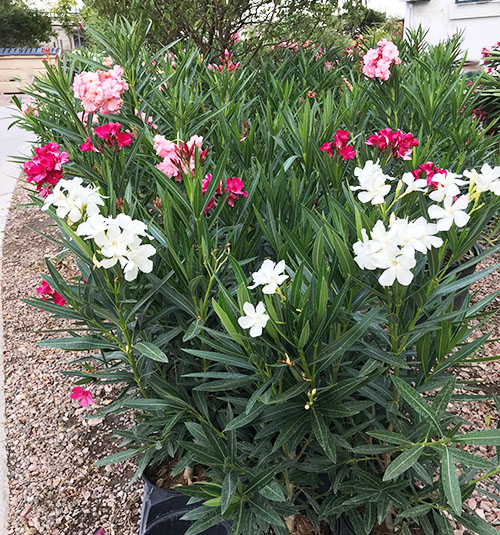
Flowering Lantana Plants
Lantanas (Verbenaceae) lantanas are in the verbena family. These are colorful plants that will do well in poor soil.
They do require lots of water for the first 2-3 years after planting but only need occasional watering after they are established. It is advisable to trim down the root system during the winter seasons. Cover with mulch or burlap to keep the roots from freezing. Some folks manage to make this plant into a small patio tree. See the image below.

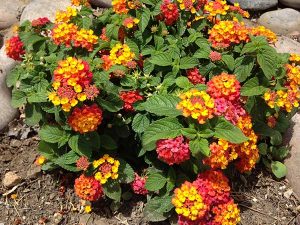

Palo Verde Tree (Cercidium floridum) Is a great-looking yellow flowering tree, deciduous. The bark of the branches and trunk is a green color thus the Spanish name “Palo Verde” translates to – Green Stick in English. Needs moderate watering during the first 2-3 years after planting. It will grow to about 15-20 ft fall and 30 ft. wide. A great shade tree for the southwest.
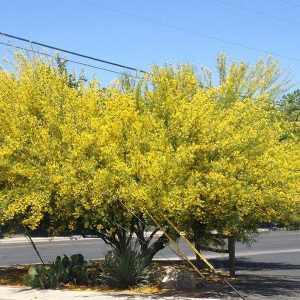
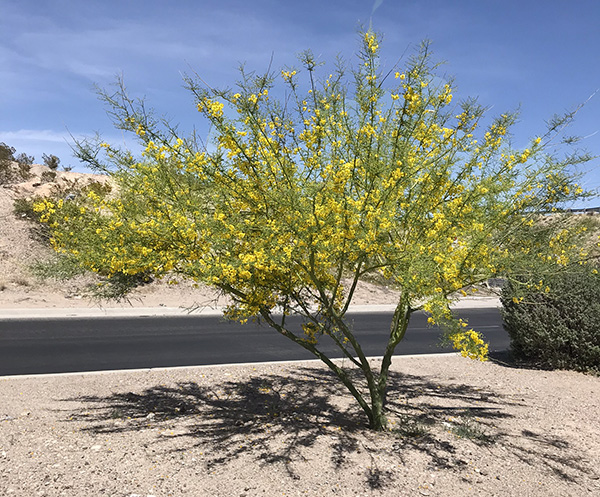
Afghan Pine (Pinus eldarica) A fast-growing desert pine tree. Also called the Mondell pine, Eldarica Pine, and Desert Christmas tree pine. It will within time grow to about 50-60ft. tall and 20 ft. wide. It requires little to no water after its 3rd year in the ground. Use them as a border wall or windscreen. Trim the bottom branches for a nice evergreen shade tree. They do produce lots of pine needles and pinecones. This will require maintenance throughout the spring season.
Xeriscape landscaping ideas
Another Great low water tree is the Desert Willow Tree.
Xeriscape landscaping ideas
The Santolina Plant and a Desert Willow are good plants for a xeriscape garden. Find out more here.

Conclusion: As you can see in this post there are lots of colorful plants that will work without using lots of water. Xeriscape landscaping ideas to help the southwest save water.
More Desert plant descriptions and pictures.

Greenhouse Manager, Master Gardener, and Webmaster.
If you have any questions or enjoyed this post, feel free to share your thoughts in the comments below.



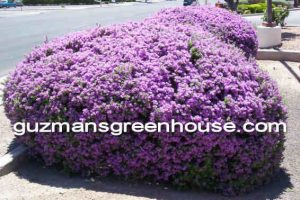


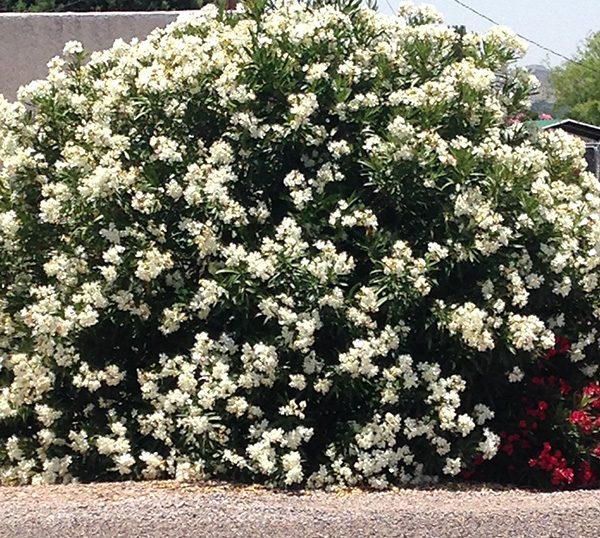
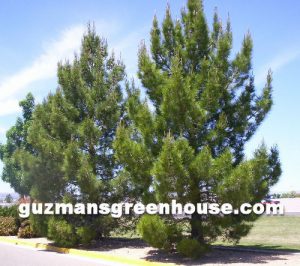



Thanks so much for all the information…love receiving your email tips on az gardening
Thanks for reading our blog Pat. Your input is welcomed.
Just forwarded this to Alamogordo City and Park officials. Great information. You folks are a valuable asset to New Mexico .
Your hearts are definitely in the right place.
Thanks!!
Thanks for the vote of confidence Gene.
You know what? I’m trying to get inspiration for a landscaping project my wife and I started for our house. I like how you incorporated natural materials like wood and stone to these projects. I’m a fan of minimalist design or something eagle rock landscaping ideas, so I’m following these tips closely. Cheers!